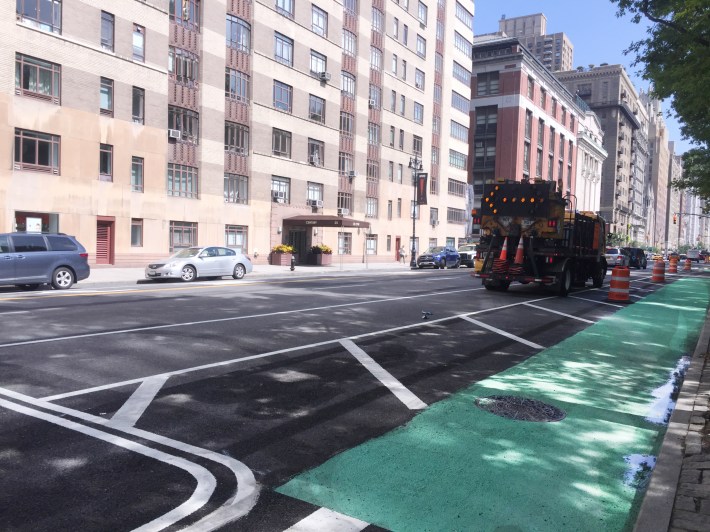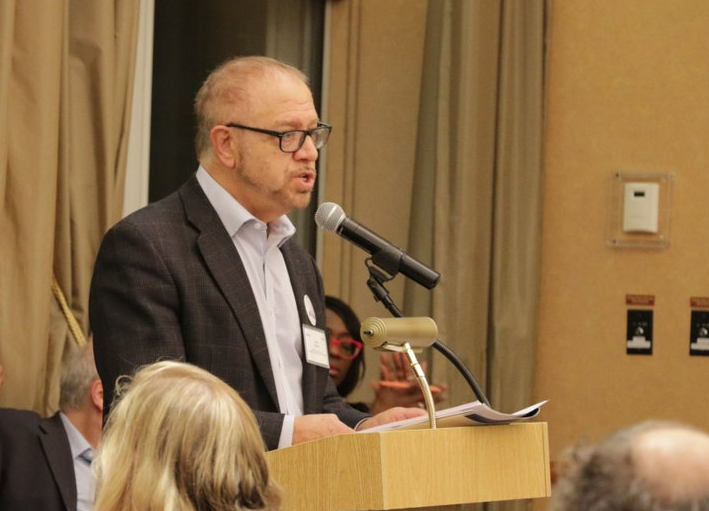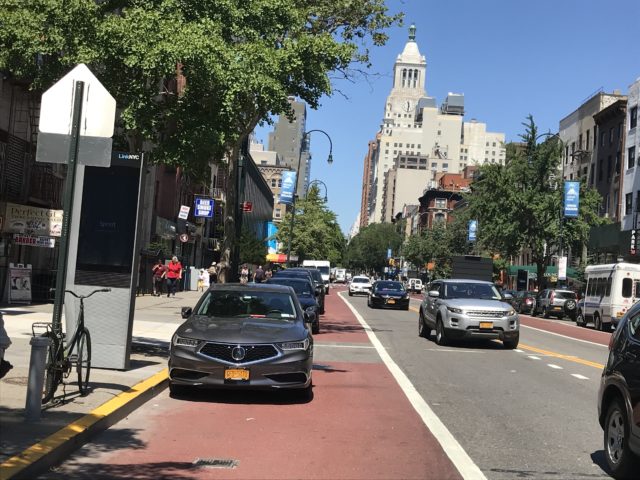Noah Kazis covered the litigation over the Prospect Park West bike lane a decade ago as a Streetsblog reporter. Now a legal fellow at the New York University Furman Center for Real Estate and Urban Policy, he returns to analyze the recent wave of lawsuits challenging street redesigns. Kazis worked for the New York City Law Department for several years but not on any of the suits discussed below.
NIMBYs have taken to the courts in a last-ditch attempt to halt badly needed bike and bus lanes on Central Park West and 14th Street — using the State Environmental Quality Review Act, or SEQRA, as the tool of choice for their spurious suits.
As a legal matter, these suits should be easy wins for the city, which generally may redesign existing streets without such a review. But there’s a reason that the Not In My Back Yard crowd — like those who for years shut down San Francisco’s bike program — loves environmental review: The costly and time-consuming litigation strains cities’ capacity and dampens agencies’ enthusiasm for street improvements like bike and bus lanes.
Bike, pedestrian, and transit advocates should know why the CPW and 14th Street suits ought to be (and are being) tossed out of court. But it’s also worth starting a conversation about ways to improve environmental review so that it doesn’t (ironically) hinder important green infrastructure.
Environmental review seeks to ensure that the government takes environmental issues – broadly defined – into account when it makes decisions. The government must take a “hard look” at a project’s potential effects, disclose its analysis and compare its plan to alternatives, including doing nothing. In New York, it must also mitigate any significant impacts if the project moves forward.
SEQRA doesn’t forbid the government from taking any action, but it does ensure that government only acts once it has studied an issue. Often, that’s important: it ensures that the government and public know whether a planned highway encroaches on an endangered species’ habitat or how many greenhouse-gas emissions would result from a new mine.
But if environmental review were required every time the government acted, public paralysis would ensue. To strike a balance, SEQRA exempts from review many government actions. These Type II actions are exempt generally either because they won’t have much environmental effect or because they are small or time-sensitive actions where environmental review isn’t feasible or worth the time and effort.
At the heart of both the CPW and 14th Street lawsuits is whether the installation of a bike or bus lane is a Type II action or a Type I action, requiring a full environmental review.
One might ask why this is a difficult question. Bikes are environmentally friendly — zero emissions — and cars are not. Give a lane from cars to bikes, help the environment. Case closed.
With buses, which move people through cities far more efficiently than cars, the analysis seems like it should be barely more complicated. For some environmental effects, like air quality or carbon emissions, or even noise and water quality, that might be right.
But, for better or worse, SEQRA takes an exceptionally expansive view of what constitutes the “environment,” including effects on parking (perversely, less parking is worse under environmental review), historic and cultural resources (few would call anyone’s street-parked 2011 Volvo a historic resource, but there are some NIMBYs who disagree), and the catch-all of “neighborhood character.”
So even the greenest improvements can have an environmental impact in one category or another. A windmill might make noise or cast shadows, for example. That’s why New York State has expressly exempted projects like smaller solar facilities from environmental review: Sometimes it’s better for the environment to take projects out of environmental review.

This raises an interesting question about how we balance different environmental values: Are bike lanes, bus lanes and road diets so environmentally beneficial that they should be exempt from environmental review? Or rather, it would, theoretically — because such projects are already exempt.
Under state rules, the “installation of traffic control devices on existing streets” is defined as a Type II action, not subject to environmental review. The term “traffic control device” isn’t defined in SEQRA, but it is defined elsewhere in state law as “[a]ll signs, markings, and devices … for the purpose of regulating, warning or guiding traffic.”
Even the petitioners in the CPW suit agree in their briefing that this definition applies. And the bike lane at issue clearly falls under that definition: It is a marking meant to regulate traffic: bikes go here, cars go there. That decides the case: installing traffic control devices on existing streets, like CPW, is not subject to environmental review.
To be doubly clear, there is well-established precedent for every step of this reasoning. As the Appellate Division explained in Vecchio v. Griffin, a case involving a village shrinking a road to one traffic lane, “Since the installation of a traffic control device on an existing highway is a Type II action … the installation did not require the preparation of an environmental impact statement or any other procedure under the State Environmental Quality Review Act.”
Likewise, appellate courts have made clear that restriping a road falls within this definition, as “pavement markings can constitute a traffic control device.” SEQRA law can be complex and difficult, but this isn’t. Installing a bike lane on an existing street just isn’t subject to SEQRA.
Honestly, the anti-bike-lane lawyers fighting the city on Central Park West don’t even really challenge this analysis. The sum total of their argument is that this bike lane is “far more comprehensive” than the ordinary traffic-control device because it involves the “major restructuring of an historic corridor with potentially grave implications” — meaning, in their view, the repurposing of 400 parking spots.
That’s it. They don’t include any citation to a case, statute, or regulation supporting their argument. The court could, and should, stop its analysis here. (In the 14th Street case, news reports say that the judge ruled that the DOT could move ahead based on the grounds that DOT had taken a “hard look” at traffic impacts.)
It’s worth pointing out that this analysis cuts both ways. When the Bloomberg administration installed barricades blocking pedestrians from crossing a ramp into the Lincoln Tunnel, a court had no difficulty concluding that the barricades’ installation was exempt from SEQRA. Just like a bike lane regulating where cars can travel, the barriers were traffic control devices regulating where pedestrians could travel.
So, bike lanes aren’t exempt because they’re green. They’re exempt because the state recognized that if DOT had to conduct an environmental review every time it added a turning lane or a stop sign or a bike lane, we’d be stuck with the streets of the past forever. No one gets to sue when DOT rips out a bike lane, either.
The CPW suit’s arguments go on from there, but since none gets around this basic exemption, there is no need to recount them. Really, any lawsuit that attaches a New York Post editorial (not even a “news” article!) as one of its core pieces of evidence, as lawyers in the CPW suit did, ought to lose. Unless the residents of the Century Condominium have managed to snag their legal representation pro bono, they’re not getting their money’s worth.

Still, it’s worth taking this rash of litigation seriously. A single bad decision, which is always a risk even when the law is on your side, could throw a wrench in DOT’s operations citywide. And even unsuccessful lawsuits still deter a city from making traffic improvements. Every suit forces DOT to spend time and energy defending itself, rather than working on another life-saving project. The better-organized or better-funded the opposition, the more motions and affidavits they can throw at the court, and the more DOT must respond.
It means that, on the margin, DOT has an incentive to avoid any project that might anger even a tiny minority of residents, so long as that minority has access to lawyers. The risk of litigation isn’t the only reason that cities nationwide — and the de Blasio administration in particular — move slowly and over-cautiously in redesigning their streets. But it doesn’t help.
So perhaps it’s time for a broader rethinking of environmental review. In an era of global climate change, does it still make sense to worry about parking and “neighborhood character” in an environmental statute? Environmental review tends to protect the status quo, and right now, the status quo isn’t working for our planet. For the greenest projects, whether that’s clean energy infrastructure, a protected bike lane or, perhaps most controversially, rezonings to promote dense, transit-oriented development, it might be time to refocus the environmental-review process.
For street redesigns, which are already exempt, administrative action could make that exemption even more explicit — the better to keep lawyers from bringing suit in the first place and judges from any risk of confusion. For actions like rezonings, where environmental review is often required, that could mean partial exemptions from environmental review, as California has tried to create, more streamlined processes for transit-oriented projects, or novel mechanisms to focus on the environmental benefits of growth in addition to its costs.
It’ll take work to strike the right balance. Environmental review is a powerful tool to inject careful environmental thinking into public decision-making. But the city’s efforts to make its transportation system safer and cleaner are being battered by environmental-review litigation — and that’s in an area where an exemption already exists. This isn’t working as well as it should. Prioritizing actual conservation, not the conservatism of the status quo, should be the top priority of environmental review.
Lawyers on both sides of the Central Park West suit are back in court on Aug. 20.







